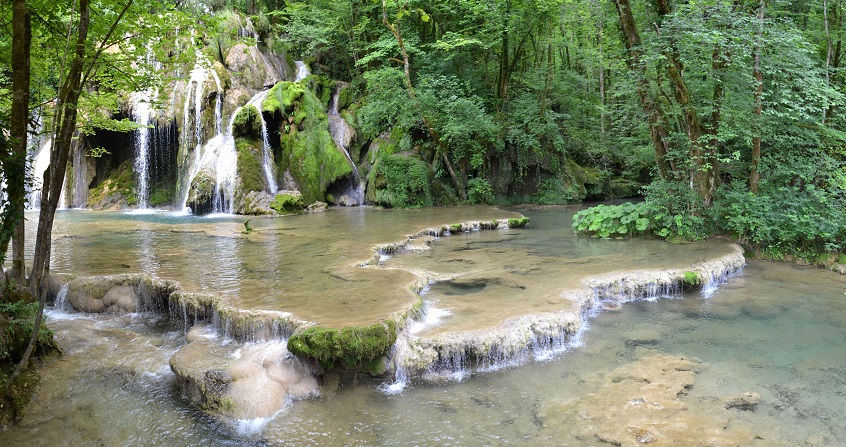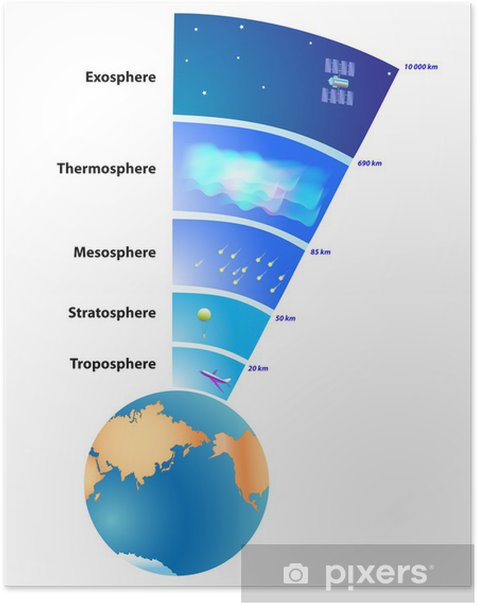The Biosphere (Ecospheres)
What Exactly is the Biosphere?
 Photo courtesy of Encyclopedia of the EnvironmentOpens in new window
Photo courtesy of Encyclopedia of the EnvironmentOpens in new window
|
The Biosphere (also known as the Ecosphere) is the area of the planet that has life. It is divided into three parts:
- The Atmosphere (the air portion),
- The Lithosphere (the land mass), and
- The Hydrosphere (the water-containing part).
Each part of the Biosphere is unique in its components. All three areas have life as well as non-living components.
- The living components, which include animals, plants, protists, fungi and bacteria, are called the biota or biotic factors.
- Non-living components are called the abiota or abiotic factors. See table X-1 for biotic and abiotic factors.
| Table X-1 Biotic & Abiotic Factors | |
|---|---|
| Biotic factors (living things) | Abiotic factors (non-living things |
| Plant-trees | Oxygen, Nigrogen, Cabon dioxide |
| Animals (e.g., zebras, insects, etc.) | Wind |
| Fungi (e.g., mushrooms, molds, etc.) | Moisture |
Protists – below is a list of some members of the protista:
| Atmospheric pressure
|
The biosphere supports between 3 and 30 million species of plants, animals, fungi, single-celled prokaryotes such as bacteria, and single-celled eukaryotes such as protozoans. Of this total, only about 1.4 million species have been named so far, and fewer than 1 percent have been studied for their ecological relationships and their role in ecosystems.
A little more than half the named species are insects, which dominate terrestrial and freshwater communities worldwide; the laborites of systematists are filled with insect species yet to be named and described. Hence, the relationships of organisms to their environments and the roles that species play in the biosphere are only beginning to be understood.
- The Atmosphere
The Atmoshphere is the part of the biosphere that contains the air. Almost all (99%) of the atmosphere is up to thirty miles from the earth’s surface. The atmosphere consists of many gases, the first four being Nitrogen (N2), Oxygen (O2), Argon (Ar) and Carbon Dioxide (CO2). Nitrogen and Oxygen make up about 99% of all the gases and the rest make up less than 1% of an unpopulated atmosphere. See Table X-2 for a more complete list of atmospheric gases.
| Table X-2 Composition of a Normal Atmosphere | ||
|---|---|---|
| Composition of Air Percent Per Volume | PPM | |
| Nitrogen (N2) | 78.09 | 780,900.00 |
| Oxygen (O2) | 20.94 | 209,400.00 |
| Argon (Ar) | .93 | 9,300.00 |
| Carbon Dioxide (CO2) | 0.0385 (and rising) | 385 |
| Neon | .0018 | 18 |
| Helium (He) | .00052 | 5.2 |
| Methane (CH4) | .00015 | 1.5 |
| Krypton (Kr) | .0001 | 1.0 |
| Hydrogen (H2) | .00005 | 0.5 |
| Nitrous Oxide (N2O) | .000025 | 0.25 |
| Carbon Monoxide (CO) | .00001 | 0.1 |
| Xenon (Xe) | .000008 | 0.08 |
| Ozone (O3) | .000002 | 0.02 |
| Ammonia (NH3) | .000001 | 0.01 |
| Nitrogen Dioxide (NO2) | .0000001 | 0.001 |
| Sulfur Dioxide (SO2) | .00000002 | 0.0002 |
Notice that Carbon Dioxide is rising, which means that percentages of the other gases are falling.
It should be pointed out that since the Industrial Revolution, which started around 1870, the CO2 concentration has been increasing. It is believed that the concentration of CO2 prior to the Industrial Revolution was around 0.0270%.
Now it is more than .02954% higher. This amount may not seem like a lot, but it is for the Earth’s systems to function properly. Cities like Los Angeles, California; Bangkok, Thailand; and Mexico, are very polluted and it is doubtful that the mentioned O2 and Nitrogen are as high as listed in Table X-2.
The atmosphere itself is divided into five major regions depending on temperature changes. See Figure X-1 for parts of the atmosphere. The main parts of the atmosphere starting with the parts that we are standing in are as follows:
- Troposhere
- Stratosphere
- Mesophere
- Thermosphere
- Exosphere – Area above the thermosphere.
 Graphics courtesy of PixersOpens in new window
Graphics courtesy of PixersOpens in new window
|
| Table X-3 The Atmosphere | |
|---|---|
| Part of the Atmosphere | Distance Above the Ground |
| Exosphere | 500 Km* (312.5 miles) |
| Thermosphere | 320 Km (196 miles) |
| Mesosphere | 80 Km (50 miles) |
| Stratosphere (good ozone here) | 50 Km (21 miles) |
| Troposphere | 12 Km (8 miles) |
| * A Km is equal to 1000 meters or .62 of a mile. 1.6 Km is equal to a mile. | |
Each area is divided up into the specific regions by something called a lapse curve. Lapse curves are areas with temperature differences. The troposphere, the first area, has falling temperatures as we go higher in altitude. From the edge of the troposphere—called the tropopause—begins the stratosphere, where temperatures begin to rise.
At the edge of the stratosphere—called the stratopause—the temperature falls again, leading to the mesosphere. This leads us to the mesopause, where the thermosphere begins, with rising temperatures again. After the thermosphere we can say that the exosphere begins. This extends up to 40,000 Km above the earth.
- The Lithosphere
The Lithosphere is the land portion of the planet. It is approximately 57.5 million square miles. One may divide the land masses into units called Biomes.
A biome can be defined as a large geographical area containing similar climate, soil, vegetation and animal life.
A list of the world’s major biomes can be seen in Table X-4.
| Table X-4 Biome Characteristics | |||
|---|---|---|---|
| Biome | High Average Temperature In Degrees Celsius | Average Rainfall in CM 2.54 CM Is Equal to 1 Inch | Biota Types |
| Tundra | 5 | 23 | Herb, birds shrubs |
| Boreal forest & temperate evergreen forest (Taiga) | 15 | 31 | Trees, shrubs, birds |
| Temperate deciduos forest | 24 | 81 | Trees, shrubs, birds |
| Temperate grasslands | 24 | 31 | Perennial grasses and shrubs |
| Cold desert | 22 | 38 | Shrubs, herbaceous plants |
| Hot desert | 38 | 15 | Plant species |
| Chaparral | 17 | 42 | Shrubs, herbaceous |
| Thorn forest and tropical savanna | 36 | 74 | Small trees, shrubs |
| Tropical deciduous forest | 27 | 163 | Decidous trees |
| Tropical evergreen forest | 21 | 262 | Trees and vines |
In theory, we can also say that the ocean consists of various biomes. There are areas with large reefs, such as the Great Barrier Reef off the coast of Australia, or even areas of the Red Sea with its higher salinity than other oceans. These areas of the ocean have their own endemic (found only in one place) aquatic life.
It should be pointed out that Mother Nature in his/her infinite wisdom made all the biomes of the Earth suitable for specific organisms.
The Earth was kept in balance until humans came alogn to disrupt it. These biomes play a significant role in maintaining the Earth’s systems, which to put it bluntly, include the life support systems that we all need to survive.
- The Hydrosphere
The hydrosphere includes water that is on the surface of the planet, underground, and in the air. A planet's hydrosphere can be liquid, vapor, or ice. On Earth, liquid water exists on the surface in the form of oceans, lakes and rivers.
The hydrosphere contains 1.36 billion cubic kms of water on the Earth. Water makes up about 70% of the Earth’s surface, with oceans being the major aquatic biome, accounting for the wide variety of life as well as supplying oxygen through photosynthesis — the oxygen that we need to breathe. About 97.6% of all the water on the Earth is saltwater found in oceans. The rest of the water, which is considered freshwater, makes up the rest.
| Table X-5 Worlds Water Resources | |
|---|---|
| Water Source | % Total |
| Ocean | 97.6 |
| Ice and snow | 2.07 |
| Groundwater down to 1 km | 0.28 |
| Lakes and reservoirs | 0.009 |
| Saline lakes | 0.007 |
| Soil moisture | 0.005 |
| Biological moisture and plants and animals | 0.005 |
| Atmosphere | 0.001 |
| Swamps and marshes | 0.003 |
| Rivers and streams | 0.0001 |
It should be pointed out that we are losing groundwater due to extensive agriculture usage, which is quite wasteful because much of the water is lost to evaporation and doesn’t make it to the crops. It is also evident that future wars will be fought over this precious resource. Misuse of the world’s water supplies will lead to more disease as is evidenced with increased dams. Stagnant water sitting in the reservoirs has the potential to be breeding grounds for mosquitoes which may carry malaria and other diseases.
As mentioned previously, the biosphere is our life support system of which we humans are all a part. When we destroy various parts of the biosphere, as in warefare or just for profit by taking available trees and making paper and furniture out of them, we are damaging our life support, perhaps forever.
Resources of the Biosphere
Life on Earth depends on the harnessing of solar energy by the process of photosynthesisOpens in new window. Photosynthetic plants convert solar energy into the chemical energy of living tissues, and that stored chemical energy flows into herbivores, predators, parasites, decomposers, and all other forms of life.
In the photosynthetic process, light energy is absorbed by the chlorophyll molecules of plants to convert carbon dioxide and water into carbohydrates and oxygen gas. Proteins, fats, nucleic acids, and other compounds also are synthesized during the process, as long as elements such as nitrogen, sulfur, and phosphorus are available.
Most solar energy occurs at wavelengths unsuitable for photosynthesis. Between 98 and 99 percent of solar energy reaching the Earth is reflected from leaves and other surfaces and absorbed by other molecules, which convert it to heat. Thus, only 1 to 2 percent is available to be captured by plants.
The rate at which plants photosynthesize depends on the amount of light reaching the leaves, the temperature of the environment, and the availability of water and other nutrients such as nitrogen and phosphorus.
The measurement of the rate at which organisms convert light energy (or inorganic chemical energy to the chemical energy of organic compounds is called primary productivity. Hence, the total amount of energy assimilated by plants in an ecosystem during photosynthesis (gross Primary Production) varies among environment. Productivity is often measured by an increase in biomass, a term used to refer to the weight of all living organisms in an area. Biomass is reported in grams or metric tons.
- Sadava. D, H.C. Heller, G.H. Orians, W. Purves, D.M. Hillis. Life: The Science of Biology, 8th edition. Sinauer Associatews and W.H. Freeman and Company 2008.
- Cunningham, W.M. Cunningham and B. Saigo, Environmental Science: A Global Concern., McGraw Hill, 2007, p.374.
- The Calvin cycle takes place in the stroma, the part of the chloroplast where CO2 is converted to sugars.
- Wilson, E. O. “Vanishing before our eyes.” Time Magazine April-May 2000, pp. 29 – 30.
- R. Costanza, R. d’Arge, R.de Groot, S. Farber, M.Grasso B. Hannon, K. Limburg, S. Naeem, R.V.O’Neil, J. Paruelo, R. Raskin, P. Sutton and M. van den Belt, “The Value of the World’s Ecosystem Services and Natural Capital,” Nature 385 (May 1997): 253 – 262.

